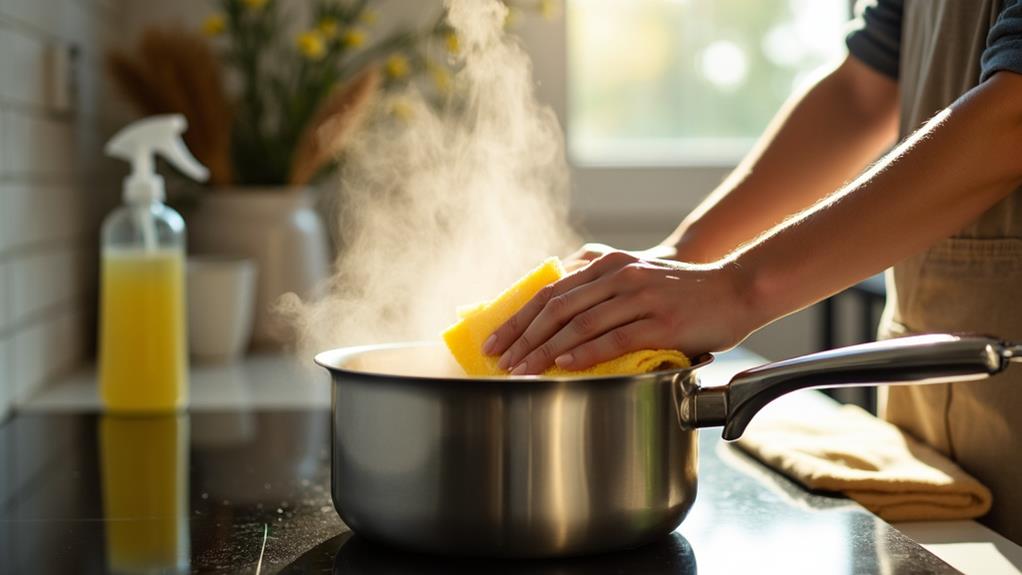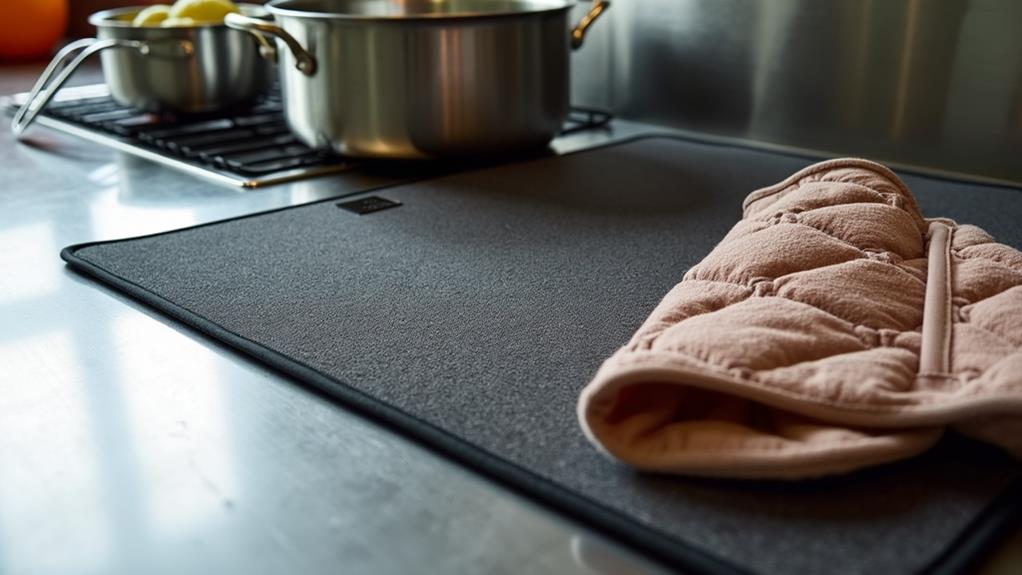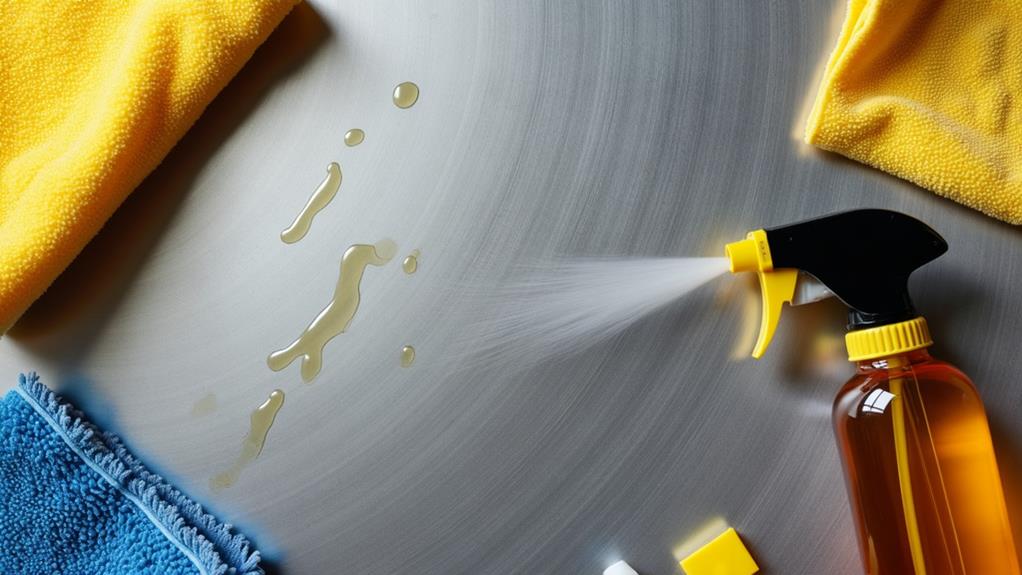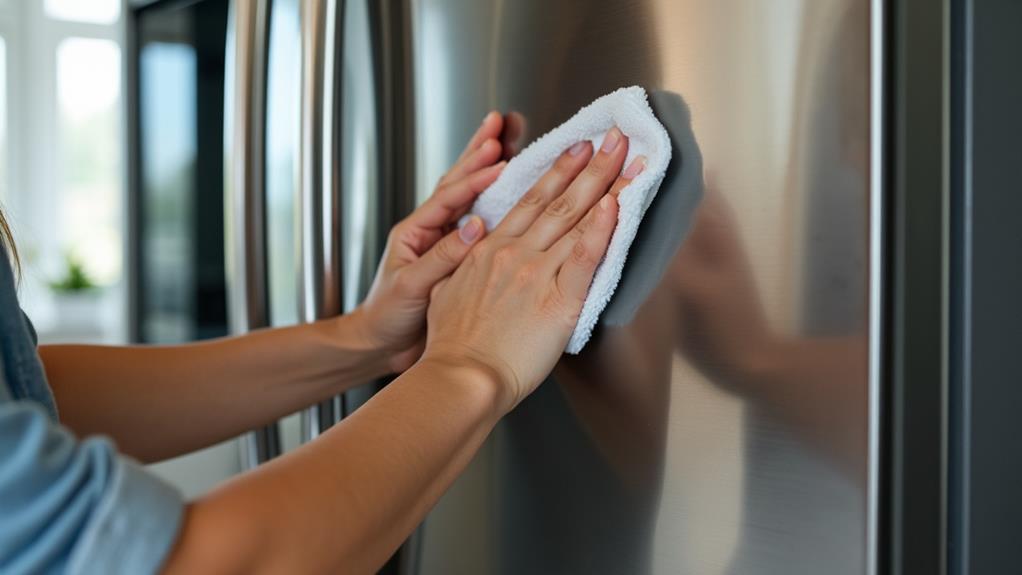How to Remove Stains From Stainless Steel Pots and Pans
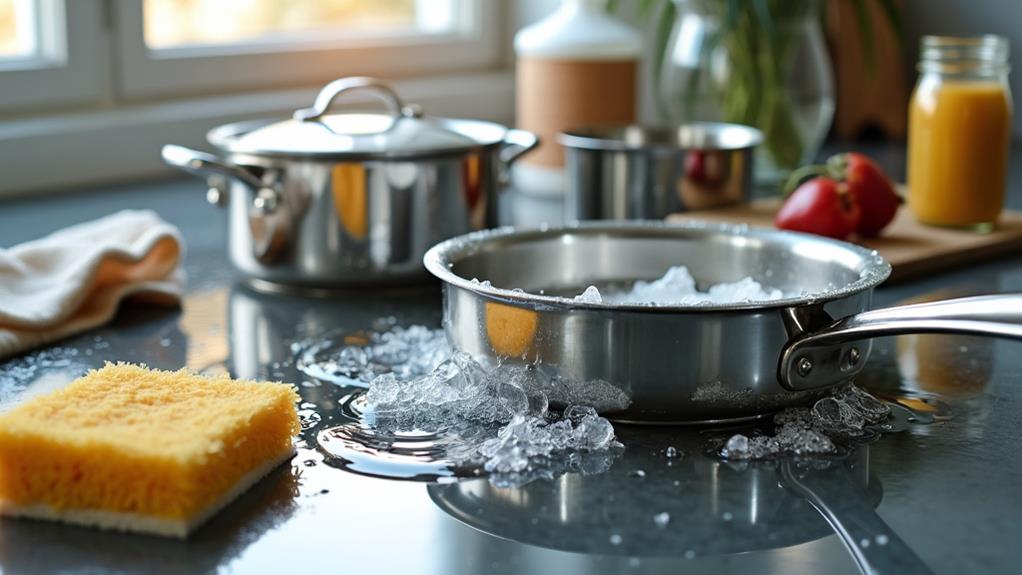
To remove stains from stainless steel pots and pans, start by using a mixture of warm water and vinegar or baking soda. Scrub gently with a non-abrasive sponge in circular motions to lift stains without scratching. For tougher stains, try a lemon and salt scrub or apply Bar Keepers Friend, letting it sit before scrubbing. Always rinse thoroughly and dry with a microfiber cloth to prevent water spots and restore shine. Regular maintenance, such as drying immediately after washing and using proper cleaning tools, can help keep your cookware spotless. For supplementary tips, here's where you can find out more.
Common Causes of Stains
Stainless steel pots and pans can develop stains for several reasons, even though they're known for their durability and resistance to corrosion. One common culprit is oil splatters. When you cook at high temperatures, oil can splatter and leave behind a residue. Over time, this residue can turn into sticky, hard-to-remove stains.
Another frequent cause is hard water. If your tap water contains a high mineral content, you might notice a chalky film or white spots on your stainless steel cookware. These spots are caused by calcium and magnesium deposits left behind when the water evaporates.
Additionally, if you don't dry your pots and pans thoroughly after washing, water spots can form, leading to unsightly stains. Acidic foods like tomatoes or vinegar can also cause discoloration if left in the pan for too long.
Improper cleaning methods, such as using abrasive sponges or harsh chemicals, can scratch the surface, making it more prone to staining. By understanding these common causes, you can take steps to prevent stains and keep your stainless steel cookware looking pristine. Regular cleaning and proper maintenance go a long way in preserving their shine and functionality.
Essential Cleaning Tools
Regarding keeping your stainless steel pots and pans spotless, having the right cleaning tools is vital. To begin with, you'll need a variety of cleaning supplies to tackle different types of stains. A soft sponge is a must for everyday cleaning, as it won't scratch the surface. For tougher stains, effective scrubbers like non-abrasive scouring pads are invaluable. These pads provide the scrubbing power needed without damaging the stainless steel.
Microfiber cloths are another vital tool. They're perfect for buffing and polishing your pots and pans once the stains are removed. They help restore the shine and remove any residual water spots. Furthermore, a good quality dish soap is critical. Look for one that's tough on grease but gentle on stainless steel.
A nylon brush can also come in handy. It's great for getting into those hard-to-reach areas like the corners and rims of your pots and pans. Finally, always keep a dedicated stainless steel cleaner in your arsenal of cleaning supplies. It's specially formulated to remove stains and restore the luster of your cookware. With these tools, you'll maintain your stainless steel pots and pans in pristine condition.
Vinegar and Baking Soda
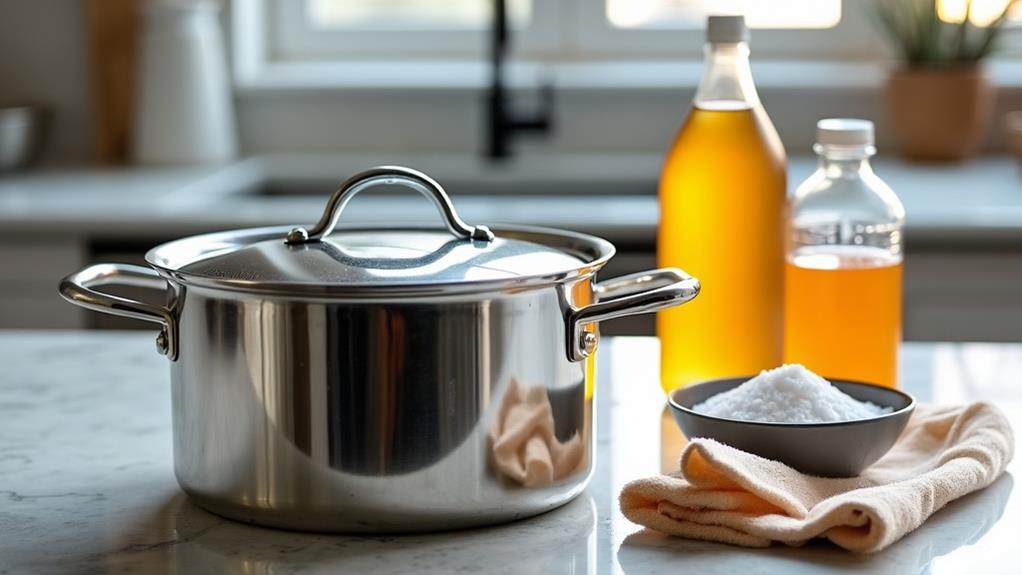
Regarding natural cleaning solutions, vinegar and baking soda are a powerful duo. They work wonders on stainless steel pots and pans, tackling even the toughest stains. Start by filling your stained pot or pan with enough warm water to cover the affected areas. Add a cup of white vinegar to the water. The vinegar benefits are twofold: it loosens stuck-on food and helps dissolve mineral deposits.
Bring the vinegar-water mixture to a boil and let it simmer for about five minutes. This process softens the stains and makes them easier to remove. After turning off the heat, carefully pour out the mixture.
Now, sprinkle a generous amount of baking soda over the stained areas. Baking soda acts as a mild abrasive, helping to scrub away residue without scratching the stainless steel. Use a non-abrasive scrubber or sponge to gently scrub the surface in circular motions.
Once you've scrubbed away the stains, rinse the pot or pan thoroughly with warm water and dry it with a clean cloth. Your stainless steel cookware should now look as good as new, thanks to the combined power of vinegar and baking soda.
Lemon and Salt Method
One of the most effective and natural ways to tackle tough stains on your stainless steel pots and pans is by using the lemon and salt method. This simple yet powerful combination utilizes the natural cleaning properties of lemon juice benefits and the salt abrasiveness to remove stubborn spots and discolorations.
First, cut a lemon in half and squeeze its juice over the stained areas of your pot or pan. The acidity in lemon juice benefits you by breaking down grease and mineral deposits that can cause those unsightly stains. Next, generously sprinkle salt over the lemon juice. The salt abrasiveness helps scrub away the loosened grime without scratching the stainless steel surface.
Now, use the lemon half as a scrubber. Rub it over the salted areas, applying a bit of pressure to help lift the stains. You'll notice that the combination of lemon juice and salt works quickly to dissolve and dislodge the dirt. After scrubbing, rinse the pot or pan thoroughly with warm water and dry it with a clean towel to avoid water spots.
This method not only leaves your cookware spotless but also imparts a fresh, citrusy scent. Give it a try and see the difference!
Using Bar Keepers Friend
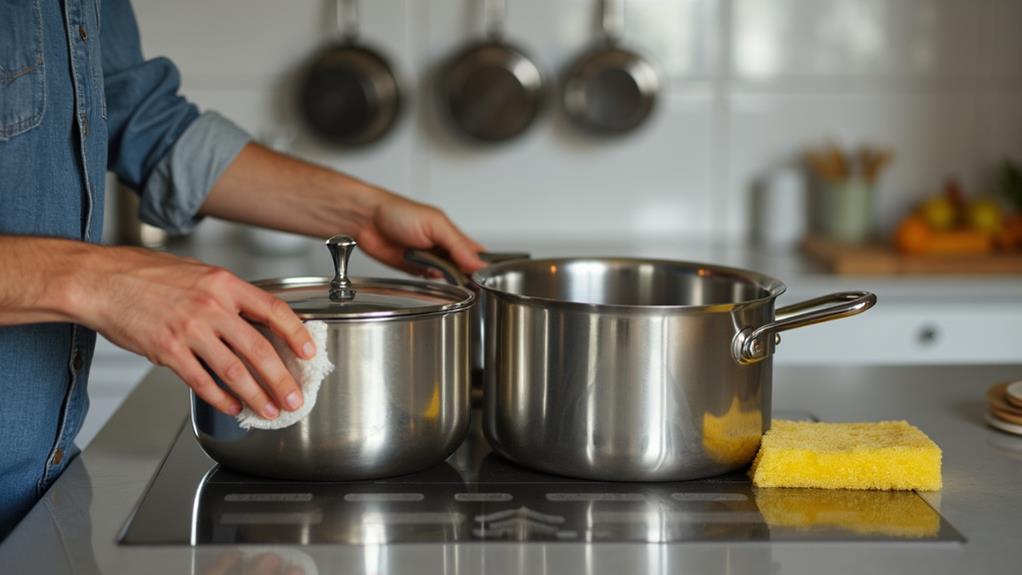
In relation to tackling stubborn stains on stainless steel, Bar Keepers Friend is a game-changer. This versatile cleaner stands out among kitchen necessities for its effective stain removal properties. To start, wet the surface of your stainless steel pot or pan. Sprinkle a small amount of Bar Keepers Friend onto the stained area. It's vital to use a damp sponge or cloth to create a paste with the powder. This paste is fundamental to the cleaning techniques that make this product so effective.
Gently scrub the surface using circular motions. You'll notice the stains starting to lift almost immediately. For tougher stains, let the paste sit for a couple of minutes before scrubbing. Make sure you don't use a steel wool pad, as it can scratch your stainless steel. After scrubbing, rinse the pot or pan thoroughly with warm water to remove any residue. Dry it with a clean towel to prevent water spots.
Bar Keepers Friend not only makes stain removal easy but also restores the shine to your stainless steel cookware. Incorporating this cleaner into your routine can keep your kitchen necessities looking brand new. So, give it a try and see the difference it makes!
Tackling Burnt-On Food
Dealing with burnt-on food can be frustrating, but there's an effective way to handle it without damaging your stainless steel cookware. Initially, fill your pot or pan with enough water to cover the burnt areas and bring it to a boil. This step is essential for heat management, as the boiling water helps to loosen the stubborn food particles. After letting it boil for a few minutes, allow the water to cool down slightly.
Next, pour out most of the water, leaving a small amount to cover the bottom. Sprinkle a generous amount of baking soda over the burnt areas. Let it sit for about 10 minutes to give it time to work its magic.
Now, it's time to explore scrubbing techniques. Use a non-abrasive scrubber or a sponge to gently scrub the surface. Avoid using steel wool or other harsh scrubbers that could scratch the stainless steel. If the food is still sticking, create a paste with baking soda and water, and apply it directly to the burnt spots. Scrub again until the burnt food is removed. Rinse the pot or pan thoroughly and dry it with a clean towel.
Preventing Future Stains
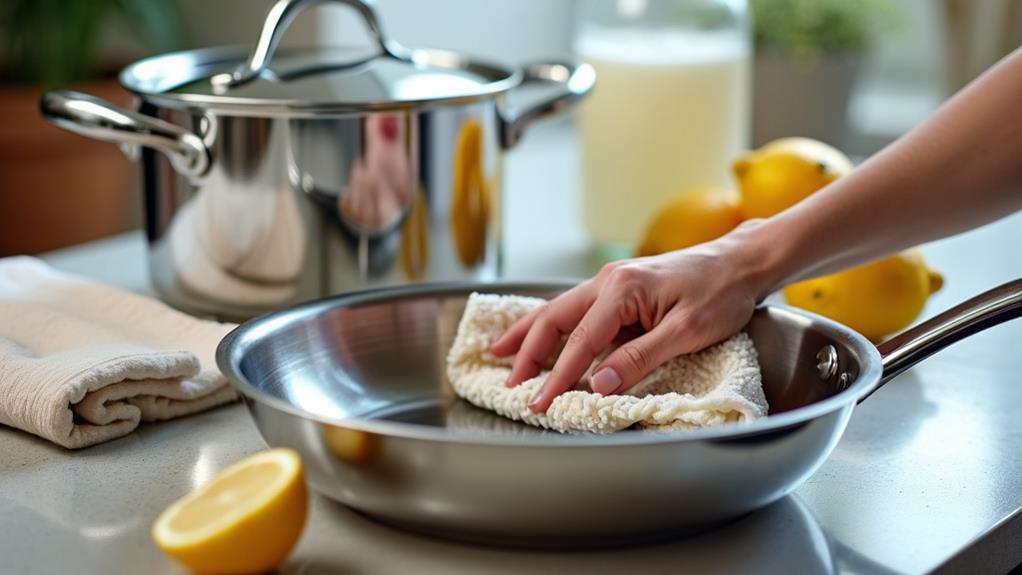
Maintaining the pristine look of your stainless steel pots and pans is easier when you adopt a few simple habits. Initially, consider investing in high-quality stainless steel coatings. These coatings act as a protective layer, reducing the risk of stains and making cleanup a breeze.
Next, pay attention to your cooking techniques. Avoid cooking on high heat unless absolutely necessary, as excessive heat can cause discoloration and stubborn stains. Instead, cook on medium or low heat and allow your pots and pans to heat gradually. This not only helps in preventing stains but also guarantees even cooking.
Additionally, be mindful of the ingredients you use. Acidic foods like tomatoes and vinegar can cause staining if left in the pot for too long. Here are three key habits to keep in mind:
- Use stainless steel coatings: These provide an extra layer of protection against stains and scratches.
- Control your cooking techniques: Stick to medium or low heat to prevent discoloration.
- Monitor ingredient interactions: Remove acidic foods promptly to avoid prolonged exposure.
Regular Maintenance Tips
Keeping your stainless steel pots and pans in top condition doesn't have to be a chore. Regular maintenance is key to preserving their shine and functionality. Start by establishing a consistent cleaning frequency. After each use, wash your pots and pans with warm soapy water and a non-abrasive sponge to prevent food residue from building up. Rinse thoroughly and dry immediately to avoid water spots.
For polishing techniques, use a mixture of baking soda and water. Apply the paste with a soft cloth, rubbing in the direction of the grain. This will help maintain the natural luster of your stainless steel. Rinse and dry completely after polishing. You might also consider using specialized stainless steel cleaners available in stores, following the manufacturer's instructions for the best results.
Don't forget to address the exterior of your pots and pans. Wipe them down regularly with a damp cloth to remove fingerprints and smudges. A quick polish once a month will keep them looking their best. By sticking to these regular maintenance tips and incorporating effective cleaning and polishing techniques, your stainless steel cookware will stay in great shape for years to come.

